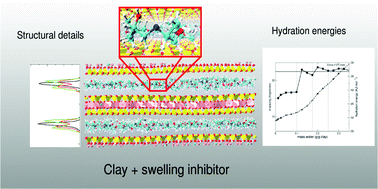In oil and gas drilling operations, drilling fluids perform essential tasks such as lubricating the drill bit, providing hydrostatic pressure and removing drill cuttings. One important function of the drilling fluid is to stop compacted clay minerals, commonly encountered in drilling operations, from taking up water from the drilling fluids and consequently swelling. Such a scenario can have an adverse impact on drilling operations and may lead to significantly increased oil well construction costs. With increasingly stringent environmental guidelines determining which swelling inhibitors are available for use in the oilfield as drilling fluid additives, there is a need to fully understand the mechanisms of clay hydration in order to design new swelling inhibitors which conform to evolving regulations. Using a range of computational techniques and analysis, combined with known experimental results, we have devised a set of “rule-based” design criteria for clay-swelling inhibitors. To achieve this, we have formulated a hydration energy parameter, which assesses the changes in energy during the step-wise progression from mono- to bi- to trilayers of water in the clay sheet galleries. This parameter can be used to rationalise and predict the swelling profiles for clays containing both cationic and neutral clay swelling inhibitors. The rules we have devised are as follows: (i) Cationic inhibitors should be able to replace sodium ions in the interlayer. (ii) Cationic inhibitors should possess a water soluble, hydrophobic backbone. (iii) Cationic inhibitors should have primary di-amine or mono-quaternary amine functionality. (iv) Cationic inhibitors should have little alcohol functionality. (v) The hydrophobic backbone of the cationic inhibitor should be long enough to form a dense monolayer in the interlayer. (vi) For neutral inhibitors, the inhibitor should be a water soluble organic molecule of low molecular weight with well defined domains of relatively high hydrophobicity and small domains of hydrophobicity. Our “rule-based” criteria will facilitate the rational design of improved—and more environmentally acceptable—clay swelling inhibitors for oilfield drilling operations.

You have access to this article
 Please wait while we load your content...
Something went wrong. Try again?
Please wait while we load your content...
Something went wrong. Try again?


 Please wait while we load your content...
Please wait while we load your content...